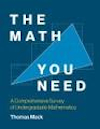- About MAA
- Membership
- MAA Publications
- Periodicals
- Blogs
- MAA Book Series
- MAA Press (an imprint of the AMS)
- MAA Notes
- MAA Reviews
- Mathematical Communication
- Information for Libraries
- Author Resources
- Advertise with MAA
- Meetings
- Competitions
- Programs
- Communities
- MAA Sections
- SIGMAA
- MAA Connect
- Students
- MAA Awards
- Awards Booklets
- Writing Awards
- Teaching Awards
- Service Awards
- Research Awards
- Lecture Awards
- Putnam Competition Individual and Team Winners
- D. E. Shaw Group AMC 8 Awards & Certificates
- Maryam Mirzakhani AMC 10 A Awards & Certificates
- Two Sigma AMC 10 B Awards & Certificates
- Jane Street AMC 12 A Awards & Certificates
- Akamai AMC 12 B Awards & Certificates
- High School Teachers
- News
You are here
The Math You Need

Publisher:
MIT Press
Publication Date:
2023
Number of Pages:
496
Price:
55.00
ISBN:
9780262546324
Category:
Textbook
[Reviewed by , on ]
Bill Satzer
11/21/2023
This book is designed to provide a compact and comprehensive guide to the primary subjects of undergraduate mathematics. It is aimed at current and prospective math majors who want a perspective on what their future studies might include. But it is also constructed to allow people who have studied mathematics in the past to refresh their prior studies in specific areas, as well as for scientists in other fields who want to explore specific topics like group theory or topology. Whether it limits itself entirely to undergraduate mathematics is arguable, but the author has made careful and deliberate choices.
Two other recent books Advanced Mathematics: An Invitation in Preparation for Graduate School and All the Math You Missed (but Need to Know for Graduate School) are generally similar in goal and content, but the audience here is different and the current book is more comprehensive.
The author calls his approach “dense … in the Bourbaki style”, but by this he seems to mean progressing logically through the material and taking advantage of the machinery previously developed, and not so much Bourbaki’s austere, often unattractive exposition.
The subjects that are included are ones you might expect. The author begins with group theory, linear algebra, and commutative algebra and proceeds through topology, analysis (single variable, multidimensional and complex), and then number theory and probability. The author of a book like this has to make hard choices to keep it usable and of a reasonable length. It is also naturally influenced by the author’s interests. Here that means that the treatment of some of the algebraic topics is more detailed and technical, for example. On the other hand, mathematical logic is not discussed at all, and differential equations are incorporated only very briefly in the context of analysis. The topology section is largely point-set topology, focuses mostly on metric spaces, and touches briefly on homotopy theory. Geometry is mostly absent but gets a brief mention in the context of multivariable analysis.
The author suggests that the book requires essentially no prerequisites. However, because the approach is a fully rigorous one with many theorems and proofs all the way through, it might be a tough read for a relatively unseasoned undergraduate. The ability to read and follow detailed mathematical arguments is clearly necessary.
Associated with every topic are a considerable number of exercises (including some that lead the student to more advanced results), as well as references for exploring further.
Compared with the two related books cited above, this one is more intense and more rigorous. The author’s introduction recalls his interest as an undergraduate in learning as much mathematics as he could as quickly as possible, and a desire for a book that would support that. Having never found that book, he wrote it himself.
Bill Satzer (bsatzer@gmail.com), now retired from 3M Company, spent most of his career as a mathematician working in industry on a variety of applications. He did his PhD work in dynamical systems and celestial mechanics.
- Log in to post comments




